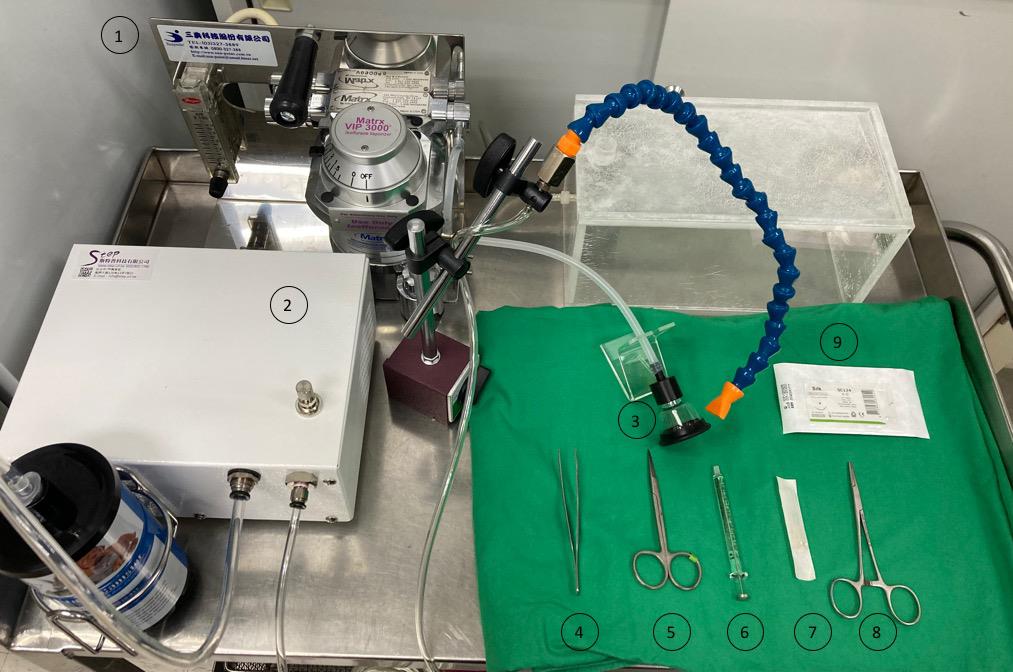- EN - English
- CN - 中文
Direct Adeno-associated Viruses Injection of Murine Adipose Tissue
小鼠脂肪组织腺相关病毒直接注射
发布: 2023年05月20日第13卷第10期 DOI: 10.21769/BioProtoc.4674 浏览次数: 1756
评审: Mohammed Mostafizur RahmanRachael E. HokensonAnonymous reviewer(s)
Abstract
The adipose tissue is a central metabolic organ that regulates whole-body energy homeostasis. The abnormal expansion of adipose tissue leads to the progression of obesity. The adipose tissue microenvironment is affected by pathological hypertrophy of adipocytes, highly correlated with systemic metabolic disorders. In vivo genetic modification is a great tool for understanding the role of genes involved in such processes. However, obtaining new conventional engineered mice is time consuming and costly. Here, we provide a simple and speedy method to efficiently transduce genes into adipose tissue by injecting the adeno-associated virus vector serotypes 8 (AAV8) into the fat pads of adult mice.
Keywords: Adipose tissue (脂肪组织)Background
Obesity is a severe global health problem characterized by excess adipose tissue expansion and strongly associated with metabolic diseases such as diabetes, cardiovascular and hepatic lipid diseases, and some types of cancers (Haslam and James, 2005; Swinburn et al., 2011; Wabitsch et al., 2015). The growth of the adipose tissue can be attributed to the enlargement of the existing adipocytes (hypertrophy) or the formation of new adipocytes (hyperplasia) (Salans et al., 1973; Spalding et al., 2008; Jo et al., 2009). Unlike the protected role of adipocyte hyperplasia (Vishvanath and Gupta, 2019), hypertrophic adipocytes are more responsible for lipid homeostasis disorders and pathological consequences (Haczeyni et al., 2018). Moreover, besides its usage as a container for lipid storage, the adipose tissue also plays crucial roles in regulating metabolic and endocrine functions. Therefore, there is an urgent need to clarify the obesity pathogenic mechanism, develop safe anti-obesity therapeutic strategies, and further avoid the pandemic dimensions of obesity.
Genetic engineering of mice is a commonly used approach to clarify gene function in vivo. However, the production of new transgenic mice is time consuming and costly (Jimenez et al., 2013; Bates et al., 2020). Some undesired side effects can be observed in conventional genetically modified mice: the manipulated gene that works on the whole body may interfere with its primary function on a specific tissue. In vivo gene transfer to the target organ has become a faster, lower-cost, and more specific strategy. Using this strategy, the time points of gene delivery can be arranged based on experimental requirements. It can also eliminate the undesired effects on embryo development.
Adeno-associated virus (AAV) vectors, discovered in the 1960s, are considered one of the safest and most promising tools for in vivo delivery of gene therapies (Atchison et al., 1965; Wang et al., 2019). They are small (25–26 nm in diameter), non-enveloped viruses composed of an icosahedral capsid that contains a linear single-stranded DNA genome (approximately 4.7–4.9 Kb). In contrast to the adenovirus, retrovirus, and lentivirus, AAVs show a relatively safe profile with apathogenicity and low immunogenicity (Cao et al., 2011). They can transduce genes into dividing and non-dividing cells (Flotte et al., 1994), allowing long-term transgene expression in such tissues. Among the 13 AAV serotypes that have been identified (Pipe et al., 2019), at least three serotypes (AAV2/8/9) exhibit efficient gene transfer to adipose tissue of adult mice (O'Neill et al., 2014; Uhrig-Schmidt et al., 2014; Bates et al., 2020). Recently, we successfully applied this protocol on direct AAV8 injection into the subcutaneous adipose tissue. In this protocol, we demonstrate a detailed procedure for efficient gene delivery into adipocytes of adult mice.
Materials and Reagents
Animals: 8–12-week-old C57BL/6JNarl mice (National Laboratory Animal Center)
Rodent MD’sTM Rimadyl (Carprofen, 2 mg/tablet) (Bio-Serv, catalog number: SMD150-2)
AAV8 vectors carrying enhanced green fluorescent protein (GFP) as reporter gene driven by CMV promoter (obtained from National RNAi Core Facility at Academia Sinica, Taiwan)
PBS (Gibco, catalog number: 10010023)
75% ethanol
FORANE® isoflurane (Abbott, catalog number: B506)
Bacitracin-neomycin ointment (Shiteh, catalog number: 022990)
Equipment
Matrx® anesthesia machine (Midmark, catalog number: VIP3000) (Figure 1, ①)
Anesthetic gas recovery machine (Step, catalog number: R-600) (Figure 1, ②)
Anesthetized mouse facemask (RWD, catalog number: 68635) (Figure 1, ③)
Surgery tweezers (Shineteh, catalog number: ST-TW011) (Figure 1, ④)
Surgery scissor (Shineteh, catalog number: ST-S011PK) (Figure 1, ⑤)
50 µL syringe (Hamilton, catalog number: 80901); needles sold separately (model: 1705 LT) (Figure 1, ⑥)
Needle (30 G × ½) (BD Precision GlideTM, catalog number: 305106) (Figure 1, ⑦)
Needle holder (Shineteh, catalog number: ST-H212) (Figure 1, ⑧)
Sterilized Suture, 4-0, 12 mm 3/8 circle (UNIK, catalog number: SC124) (Figure 1, ⑨)
Biosafety Cabinet (ClassII)
Hair clipper (Orbaner, catalog number: MB-022)

Figure 1. Setup of experiment. ① Anesthesia machine, ② Anesthetic gas recovery machine, ③ Anesthetized mouse facemask, ④ Surgery tweezers, ⑤ Surgery scissor, ⑥ Syringe, ⑦ 30 G needle, ⑧ Needle holder, ⑨ Sterilized suture.
Procedure
文章信息
版权信息
© 2023 The Author(s); This is an open access article under the CC BY-NC license (https://creativecommons.org/licenses/by-nc/4.0/).
如何引用
Wu, S. C. and Lin, C. H. (2023). Direct Adeno-associated Viruses Injection of Murine Adipose Tissue. Bio-protocol 13(10): e4674. DOI: 10.21769/BioProtoc.4674.
分类
生物工程 > 生物医学工程
生物科学
您对这篇实验方法有问题吗?
在此处发布您的问题,我们将邀请本文作者来回答。同时,我们会将您的问题发布到Bio-protocol Exchange,以便寻求社区成员的帮助。
Share
Bluesky
X
Copy link










